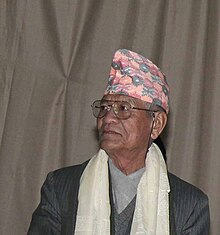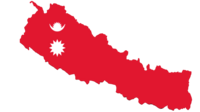Iman Xin Chemjong Limbu, or Iman Singh Chemjong Limbu; was a Limbu historian, writer, linguist, lexicographer, folklorist, and philosopher of Nepal. Chemjong devoted his entire life to studying and documenting various facets of Kirat Limbu tradition and culture at a time when such activities were frowned upon and even punished by the Nepalese ruling elite as being subversive and "anti-national". Chemjong's research into and publication of Kirant history and culture challenged perceptions of the Nepalese official doctrine that showcased Nepal as a Hindu cultural monolith devoid of alternative narratives.

The Kirati people, also spelled as Kirant, are Sino-Tibetan ethnolinguistic groups and indigenous peoples of the Himalayas, mostly the Eastern Himalaya extending eastward from Nepal to Northeast India (predominantly in the Indian States of Sikkim and Darjeeling & Kalimpong hills of northern West Bengal
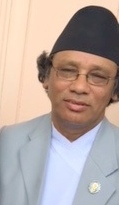
Saru Bhakta is the pen name of Bhakta Raj Shrestha, a celebrated Nepalese playwright, novelist, songwriter and poet and a winner of Madan Puraskar, one of the most prestigious literary awards in Nepal.

Nepali literature refers to literature written in the Nepali language. The Nepali language has been the national language of Nepal since 1958.
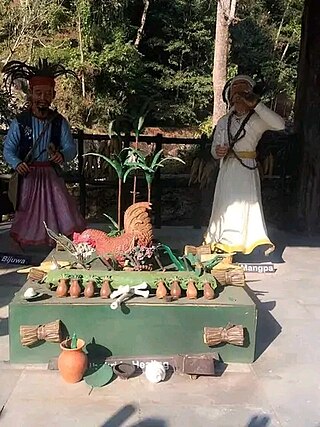
Kirat Mundum, also known as Kiratism, or Kirati Mundum, is an animistic folk religion of the Kirati ethnic groups of Nepal, Darjeeling and Sikkim, majorly practiced by Yakkha, Limbu, Sunuwar, Rai, Thami, Jirel, Hayu and Surel peoples in the north-eastern Indian subcontinent. The practice is also known as Kirat Veda, Kirat-Ko Veda or Kirat Ko Ved. According to some scholars, such as Tom Woodhatch, it is a blend of shamanism, animism, and Shaivism. It is practiced by about 3.17% of the Nepali population as of 2021.
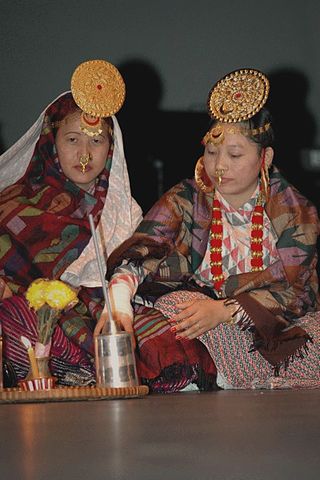
The Mundhum is the ancient religious scripture and folk literature of the Kirat people. It is an ancient, indigenous religion of Nepal. Mundhum means "the power of great strength" in the Limbu language. The Mundhum covers many aspects of the yakthung (Limbu) culture, customs and traditions that were followed since before the rise of the Vedic civilisation in the Indian subcontinent.

Indra Bahadur Rai was an Indian Nepali language writer and literary critic from Darjeeling, India. He wrote multiple essays, short stories, novels and criticism in his lifetime. Kheer and Raat Bhari Huri Chalyo are some of his most popular stories. He started a literary movement in Nepali literature known as Tesro Aayam with Ishwar Ballav and Bairagi Kainla. In 1977, he won the first ever Sahitya Akademi Award for Nepali language.

Ishwar Ballav was one of the most influential Nepali poets. He was also a poet of a new dimension–the third dimension–meaning Tesro Ayam in the history of Nepalese literature. He, along with his contemporaries Bairagi Kaila and Indra Bahadur Rai, formed a trio in 1963 in Darjeeling to rethink and evaluate the development of Nepalese literature.
Jagadamba Shree Puraskar is an award given for contribution to Nepali Language, Literature, Art and Folk Culture Field. It is awarded to a person or an organization who has contributed in the field of Nepali language, literature, art or folk culture fields.

Taranath Sharma popular name Tana Sarma was a litterateur of Nepal, recognized as travel writer, essayist and literary critic. Sharma authored over 112 books in Nepali language. He contributed to Nepali Literature for over five decades.
Kumar Pradhan was an Indian historian and writer whose research interests include the History of the Eastern Himalayas, Genealogical studies and the Nepali literature. Pradhan has also edited and written a number of literary journals and anthologies and published learned articles in Nepali. He was the chief editor of Sunchari Samachar and other prominent Nepali newspapers.
Krishna Prasad Bhattarai, professionally known as Krishna Dharabasi is a Nepali writer, novelist and literary critic. He has written multiple essays, short stories, poems and novels. He won the Madan Puraskar for his novel Radha in 2005. Jhola, one of his short stories has been adapted into a film of the same title. He is known for using meta-writing style in his fictional works.

Tesro Aayam is a literary movement founded by Ishwor Ballav, Bairagi Kainla and Indra Bahadur Rai in 1960 which triggered a new stir in Nepalese and Indian literature. This movement is considered a significant milestone in the history of Nepalese and Indian literature which signalled the beginning of Postmodernism.

Krishna Bhusan Bal was a Nepalese poet known primarily for simplifying poetry for its readers at a time when poets were inclined to grandiloquence. Carving emotions into words is considered to be one of Bal’s most intricate qualities. Bal’s personality is often compared to a poem, indifferent to race, caste, religion, and politics.
Mohan Koirala was a Nepalese poet, known for his prose poems and poems against the Rana regime. Some of this poems has been translated in English. He won Madan Puraskar in 2038 BS.

Limbuvanko Eitihasik Dastabej Sangraha 1662–1963 AD is a historical book about the Limbuwan region in eastern part of Nepal written and compiled by Bhagi Raj Ingnam. It was published on 25 December 2020 by Yakthung Publication and won the Madan Puraskar for the year 2020.
Bhairav Bahadur Thapa is a Nepalese dance director, choreographer, and scholar. He is considered as the first dance director of Nepal. Thapa passed the examination from the Public Service Commission in 2018 BS (1961-1962) and started working as a dance director in the cultural institute. After retiring from the institute, Thapa opened a dance troupe and continued his choreography work. Hundreds of artists who have taken dance training with him are established in the Nepali art field.

Bimala Tumkhewa is a Nepali poet, writer and journalist. Her works are centered around the themes of feminism and ethnic identity. She has published four poetry collections till date. She is also the General Secretary for Sancharika Samuha and a member of Women Security Pressure Group. One of her poems is included in the curriculum in first year of Bachelors of Far-western University and the sixteen constituent colleges.
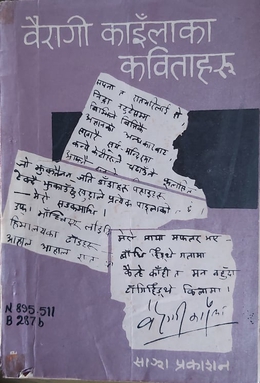
Bairagi Kailaka Kabitharu is a 1974 Nepali poetry collection by Bairagi Kainla. It was published in 1974 by Sajha Prakashan. It is the first book of the author. The poems in this collection were later reprinted in a book titled Bairagi Kainla ka Sankalit Kavita with his other poems by Phoenix Books. Kainla is known as progenitor of the Tesro Aayam movement in Nepali literature alongside Indra Bahadur Rai and Ishwor Ballav. He received the Sajha Puraskar for this book.
